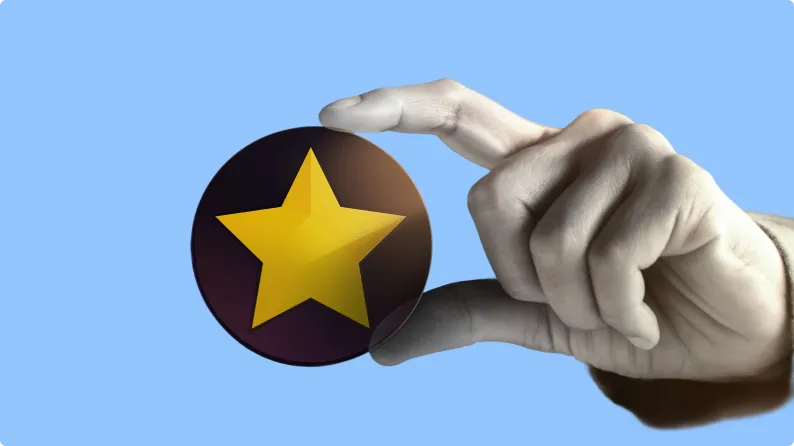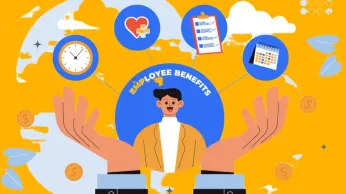On this page
An effective employee reward and recognition program goes beyond surface-level appreciation. It’s a structured, scalable approach to reinforcing behaviors that drive business performance, shape culture, and improve retention.
When designed well, recognition becomes a strategic tool—not an afterthought. Yet, many organizations still rely on ad hoc efforts or outdated models that don’t reflect how modern teams work and what employees value. The result? Low participation, poor visibility, and missed opportunities to create real impact.
In this blog, we will outline a strategic, end-to-end framework for building a high-impact employee reward and recognition program. From aligning with company goals and enabling automation to measuring ROI and driving adoption across teams, this guide will help you implement a program that works—for your people and your business.
Define the strategic purpose of r&r in your organization
Before building out processes or selecting tools, it’s important to define why a recognition and rewards program exists in the first place. Recognition isn’t a standalone initiative—it’s an expression of what your organization values. The goal is to build a system that reinforces behaviors, outcomes, and relationships that matter most to your business.
Tie recognition to business objectives and culture
Start by identifying the specific behaviors and results you want to promote. Are you aiming to improve cross-functional collaboration? Increase sales performance? Reinforce customer-first thinking? Your program should reflect those goals. Recognition tied to defined cultural values and strategic outcomes becomes more than appreciation—it becomes a behavioral signal.
Empuls’s rewards and recognition platform supports this alignment through core value badges, custom award types, and behavior-linked nominations, allowing organizations to reinforce culture consistently across teams.
Balance motivation and appreciation
Recognition serves two related but distinct purposes: motivation and appreciation. Motivation drives future performance; appreciation acknowledges effort already made. A healthy program incorporates both—recognizing milestone achievements and encouraging ongoing contribution.
Empuls enables this dual function through structured performance incentives, spot awards, and peer-to-peer appreciation, all within a configurable framework that adapts to different roles and regions.
Use recognition to foster equity and belonging
An effective program gives everyone a voice. Peer-to-peer and cross-level recognition ensures appreciation flows in all directions—not just top-down. At the same time, systems must be designed to prevent bias and uneven distribution.
Empuls helps mitigate these challenges through recognition analytics and AI-driven insights that highlight recognition trends, frequency, and outliers—making it easier for managers and HR leaders to identify and address gaps.
Stakeholder alignment: Getting buy-in from leadership to line managers
An employee rewards and recognition program is only as effective as the people who champion it. Building alignment across key stakeholders—executives, HR, people managers, and finance—is essential for long-term success. Without it, programs often stall at the pilot stage or are reduced to administrative tasks with little cultural relevance.
Start with a recognition charter
Define a clear charter outlining the program’s goals, guiding principles, governance model, and measurement metrics. This document becomes the foundation for stakeholder conversations and ensures that recognition doesn’t devolve into an inconsistent or discretionary effort. The charter should articulate how the program connects to broader organizational goals, such as reducing attrition, improving manager effectiveness, or scaling culture in distributed teams.
Empuls supports this upfront strategy phase with recognition framework templates, role-based dashboards, and policy configuration tools that translate intention into action.
Involve finance from the start
Budgeting for rewards often becomes a point of friction. Engaging the finance team early helps establish clear rules for point allocation, monetary vs. non-monetary rewards, taxation, and pay-on-redemption models. Empuls streamlines this through budget automation, pay-as-you-go billing, and tax-compliant redemption workflows, reducing financial risk and administrative overhead.
Equip managers with the right tools and signals
People managers are the bridge between strategy and execution. They need more than access—they need data and nudges. Empuls' AI assistant, Em, analyzes recognition activity, flags under-recognized team members, and prompts managers to take action, closing visibility gaps without increasing workload.
Recognition is most impactful when delivered by someone close to the work. By enabling managers to act in real time, with context, fairness, and confidence, the program becomes sustainable and deeply embedded in leadership routines.
Design a framework that balances standardization with flexibility
A well-structured rewards and recognition framework needs both consistency and adaptability. The goal is to create a repeatable system that can be governed centrally, yet still responds to the diverse needs of business units, geographies, and roles. Without this balance, programs either become too rigid to inspire participation—or too loose to deliver measurable impact.
Define award types with clear use cases
Each award type should have a defined purpose, eligibility criteria, and process. Common categories include:
- Core value recognition: Tied to behavioral alignment with company values.
- Spot awards: For immediate and visible achievements.
- Jury-based awards: For high-impact, nomination-led recognitions.
- Peer-to-peer awards: For horizontal appreciation and cultural reinforcement.
- Milestone-based rewards: Celebrating service anniversaries, onboarding, or project completions.
- Goal-linked incentives: Tied to sales, referrals, wellness, or learning outcomes.
Empuls offers built-in configurations for all of the above, with workflows that support nominations, approvals, multi-level evaluations, and budget guardrails—so HR doesn’t have to build from scratch.
Build reward cycles into the program backbone
Scheduling recognition cycles across the year helps maintain rhythm and visibility. Think quarterly awards, annual excellence ceremonies, and monthly peer-nominated spotlights. Use these cycles to promote participation, maintain momentum, and ensure every function or region has equal visibility.
Empuls makes this easy with automated reward cycles, allowing teams to set start/end dates, trigger reminders, and publish results across the organization without manual effort.
Structure budgets at every level
Budget constraints should never stall recognition. That’s why it's essential to define allocation models across departments, roles, and geographies. Empuls supports automated point allocation by role or region, budget tracking in real time, and configurable spend limits per user or team.
This ensures the program remains scalable, cost-effective, and fair—without sacrificing the freedom to personalize recognition.
Allow for program localization without losing control
Recognition preferences vary by location and role. Some teams value public acknowledgment; others prefer private appreciation. Some may favor merchandise, while others want flexibility through gift cards or experiences.
Empuls solves for this through multi-currency support, custom reward catalogs, and visibility controls—enabling local nuance without undermining global consistency.
Power recognition with AI and automation for scalability
Scaling recognition across a growing organization is challenging without automation. Manual processes break down under volume, and inconsistency creeps in. By introducing automation and AI, recognition becomes more timely, inclusive, and operationally efficient—while still feeling personal and intentional.
Move from passive to proactive recognition
In many organizations, recognition is reactive—dependent on someone remembering to act. Empuls changes this with Em, an AI-powered assistant that nudges employees to log weekly accomplishments and reminds managers to acknowledge them. These nudges are context-aware and behavior-linked, ensuring recognition happens consistently, not sporadically.
Identify and close recognition gaps
Recognition, if unevenly distributed, creates perception issues. High performers may feel overlooked, and quieter team members may go unnoticed. Empuls uses AI-driven insights to analyze recognition patterns and flag anomalies—such as under-recognized teams or favoritism clusters. This helps HR and managers intervene with data, not assumptions.
Automate award creation and delivery
Designing and issuing awards manually at scale is inefficient and error-prone. Empuls simplifies this with automated award generation, including AI-generated messages, digital certificates, and budget-calibrated rewards. Admins can predefine workflows for each award type, including who can nominate, approve, and what triggers the reward.
This automation ensures that celebrations are timely—birthdays, service milestones, performance wins—without relying on memory or spreadsheets.
Maintain control while scaling
As volume grows, control becomes critical. Empuls offers centralized dashboards for HR teams to oversee multiple programs, track spend versus allocation, and audit activity. From quarterly budget snapshots to participation heatmaps, everything is tracked and exportable—enabling strategic decisions based on actual data.
By pairing automation with AI, recognition becomes both scalable and intelligent, without sacrificing nuance or context.
Personalize the recognition experience across roles, generations, and geographies
Uniform recognition programs tend to miss the mark. What motivates a Gen Z engineer in Bengaluru may not resonate with a mid-career manager in Berlin or a frontline retail associate in Boston. Personalization ensures recognition is not only seen—but felt.
Design for diversity in reward preferences
Different roles, locations, and generations value different forms of recognition. For some, public appreciation is energizing. Others prefer quieter, direct acknowledgment. Some teams favor experiences, while others prefer gift cards, swag, or time off.
Empuls offers a global rewards catalog with over 10 million redemption options across 100+ countries, spanning gift cards, experiences, merchandise, donations, and branded swag. This breadth allows employees to choose rewards that align with their lifestyle and values, without HR having to manage logistics or curation.
Support local currencies, languages, and tax rules
Global organizations need to manage recognition without creating administrative sprawl. Empuls supports 55+ currencies and 30+ languages, along with region-specific tax compliance. This enables organizations to deploy a unified program without compromising on local relevance.
Empuls' pay-on-redemption model ensures budget is only consumed when a reward is claimed, offering better cost control while improving perceived value.
Enable recognition for deskless and distributed teams
Not every employee sits in front of a screen. Empuls solves this with mobile accessibility, QR-code-based rewards for deskless workers, and digital signage support for common areas—such as TV mode for Wall of Fame displays.
This ensures visibility and participation across all types of workers—not just those in front of a laptop.
Customize recognition moments for employee journeys
Personal milestones, career achievements, and cultural celebrations can be tailored to reflect the unique path of each employee. Empuls enables this through automated workflows for birthdays, work anniversaries, onboarding completion, and other custom events—each with optional branding and personalized messages.
Recognition that adapts to context feels more authentic and meaningful. With Empuls, that level of relevance is built into the infrastructure.
Build recognition into the flow of work
Recognition is most effective when it happens in the rhythm of everyday work—not in isolation or on delay. When employees can give and receive recognition where they already collaborate, the process becomes frictionless, visible, and embedded in the culture.
Integrate with collaboration tools
Switching between platforms to recognize someone is a barrier. Empuls removes that barrier by integrating directly with tools like Microsoft Teams, Slack, Outlook, and other daily systems. Employees can appreciate peers, nominate colleagues for awards, redeem points, or view the Wall of Fame—without ever leaving their workflow.
Empuls also plugs into core systems like HRIS, PMS, ATS, and LMS, enabling recognition triggers based on events—like onboarding completion, goal achievement, or referral success. This contextual integration automates recognition and improves adoption.
Leverage real-time visibility and celebration
Recognition shouldn’t be buried in an inbox or limited to 1:1 praise. Empuls includes a social feed where all recognitions—peer, manager, value-based, and milestone—are shared for org-wide visibility. Reactions, comments, and celebrations create a cascade of appreciation, reinforcing behaviors through public validation.
For large screens or physical spaces, Empuls offers a TV display mode of the Wall of Fame, showing recent awardees, new hires, and milestones—keeping recognition visible across the office, not just online.
Enable peer-to-peer and bottom-up recognition
When only managers recognize employees, it creates a hierarchical structure that doesn’t reflect the reality of cross-functional teamwork. Empuls supports peer-led recognition, allowing anyone to appreciate others in a few clicks—democratizing the experience and fostering a culture of gratitude across levels.
Support asynchronous and distributed teams
For hybrid and global teams, recognition needs to be asynchronous. Empuls ensures employees can send or receive appreciation regardless of time zone. Notifications are sent through preferred channels—email, app, or chat tools—and recognition logs are preserved for easy access during feedback or review conversations.
Recognition doesn’t require a new platform. It thrives when embedded into how people already work. Empuls ensures that’s not an aspiration, but an operating reality.
Make it measurable: analytics, ROI, and continuous improvement
Recognition without measurement turns into anecdotal success. To sustain an employee rewards and recognition program, it must deliver tangible value—and that value needs to be tracked, analyzed, and improved over time.
Define the right metrics early
Metrics should be tied to the business outcomes the program is designed to support. These can include:
- Participation rates: How many employees are giving and receiving recognition?
- Manager distribution: Are recognition efforts evenly spread or concentrated?
- Core value adoption: Which values are most frequently celebrated?
- Budget utilization: Are recognition points being used effectively?
- eNPS and engagement deltas: Is recognition moving the needle on employee sentiment?
- Attrition and retention trends: Are recognized employees staying longer?
Empuls gives HR teams access to all of these metrics through configurable dashboards and role-based reporting, down to team, department, or location levels.
Use AI to surface actionable insights
Manual data interpretation isn’t scalable. Empuls' AI assistant, Em, highlights anomalies—such as departments where recognition frequency is low, or budget underutilization patterns. These prompts help HR and leadership act on data in real time, instead of reviewing reports quarterly.
For example, if Em identifies a manager who hasn’t recognized any team member in a month, it can trigger a nudge or send insights to HR for follow-up. This proactive approach prevents disengagement before it takes root.
Track budget and ROI with precision
Reward spending can quickly become a concern if it lacks oversight. Empuls uses a bill-on-redemption model, meaning organizations are charged only when an employee claims a reward. This ensures the reward experience is valuable without unused budget going to waste.
Combined with monthly budget reports, point sourcing audits, and spending trend visualizations, this model offers complete financial control—especially helpful when justifying program expansion or renewal.
Close the feedback loop and optimize
Data without action limits improvement. Empuls supports feedback collection after every recognition moment, and links recognition performance with other engagement metrics. Insights feed directly into pulse surveys, action plans, and recognition cycle adjustments—making continuous improvement not just possible, but embedded in the system.
Recognition, when measured effectively, proves its impact. Empuls ensures that recognition activity isn't isolated—it’s connected to the broader employee experience and business health.
Ensure inclusivity, fairness, and compliance
Recognition loses credibility when it's inconsistent, biased, or perceived as unfair. To maintain trust, the program must be transparent, inclusive, and compliant—with guardrails that prevent misuse and ensure equity across the organization.
Monitor distribution for bias and imbalance
Recognition skewed toward high-visibility roles or extroverted employees undermines morale. Empuls offers real-time insights into recognition patterns, highlighting employees who are consistently overlooked or those receiving disproportionate recognition. These insights help HR and people leaders take corrective action, encouraging broader participation.
Empuls also includes quid pro quo detection—flagging unusual patterns between individuals that may indicate favoritism. These reports help organizations enforce fairness without intrusive oversight.
Enable choice and accessibility for all employees
A one-size reward experience alienates parts of the workforce. Empuls allows employees to choose from a globally accessible catalog tailored by country, role, and personal preference—ensuring that every employee, regardless of location or department, can find something meaningful.
The platform also supports multi-language interfaces, accessibility standards (WCAG-compliant), and mobile access, creating a consistent experience for deskless, remote, or differently-abled employees.
Stay compliant with tax and data regulations
Service awards, monetary rewards, and fringe benefits come with tax implications that vary by geography. Empuls simplifies this complexity with built-in tax compliance tools, including support for pay-on-redemption, automated reporting, and regional configuration for tax-free reward categories.
The platform also adheres to GDPR, ISO 27001, SOC 2, HIPAA, and CCPA, ensuring that employee data is processed securely and in line with global standards.
Protect digital spaces with moderation controls
Recognition often involves public messaging—on social feeds, wishboards, and leaderboards. Empuls uses AI-based content moderation to flag inappropriate language, discriminatory content, or policy violations in real time. This helps maintain a respectful environment without placing additional burden on HR teams.
Fairness isn’t accidental—it’s designed. Empuls helps organizations build that integrity into their recognition infrastructure from day one.
Launch, evangelize, and sustain the program
The most well-designed recognition program can still fail if it doesn’t gain traction with employees. Adoption hinges on clarity, visibility, ease of use, and consistent reinforcement. A strong launch backed by ongoing internal advocacy ensures the program becomes part of daily culture—not another HR initiative that fades out.
Position recognition as culture, not compliance
To encourage buy-in, communicate the why behind the program—how it reflects the company’s values, reinforces desired behaviors, and benefits everyone. Use leadership messaging to set the tone, and involve early champions to model recognition behavior from day one.
Empuls offers branded homepages, banners, and launch collaterals so organizations can create a familiar, engaging environment. It also supports custom nomenclature and program theming to reflect internal language and tone.
Train people leaders and peer influencers
Recognition culture is shaped by those who lead by example. Equip managers and influential employees with micro-training, best practice toolkits, and recognition checklists. With Empuls, HR teams can assign role-specific guides and track manager participation through dashboards—spotting gaps early and offering targeted support.
Drive awareness through broadcast and rituals
Recognition must be seen to be reinforced. Empuls makes this easier with features like:
- Social feeds and leaderboards to highlight ongoing recognition
- Wall of Fame (TV and interactive modes) to spotlight contributions across the org
- Wishboards for work anniversaries and celebrations
- Push notifications and reminders tied to recurring events
These tools transform recognition into a daily touchpoint, integrated into employee experience rather than confined to quarterly updates.
Keep the momentum going
After launch, maintain momentum with recurring campaigns—like “Thank You Thursdays,” themed recognition weeks, or peer-nomination contests. Empuls supports campaign scheduling, automated reminders, and calendar-based reward cycles to sustain participation throughout the year.
In addition, Empuls’ CSM-led adoption programs, survey-based feedback collection, and ongoing optimization support ensure that HR has both the insight and resources needed to evolve the program over time.
Recognition is not a one-time launch—it’s a rhythm. With the right tools, visibility, and reinforcement, it becomes a durable part of your company’s culture.
Employee rewards and recognition programs: 5 common mistakes to avoid
Even thoughtfully designed programs can fall flat if key principles are overlooked. To maximize impact and credibility, avoid these common errors that often undermine employee reward and recognition efforts.
1. Centralizing ownership with HR alone
Recognition thrives when it’s part of the company’s culture—not just a function of HR. Limiting ownership to one department often results in low visibility, poor adoption by managers, and minimal strategic alignment. Instead, recognition should be shared across leadership, team managers, and even peers to create collective accountability and momentum.
2. No clear link to business goals or cultural values
When recognition is generic or purely transactional, it loses meaning. Programs disconnected from what the organization actually values—like innovation, collaboration, or customer focus—fail to shape behavior. Every award or acknowledgment should reflect specific values or outcomes that the company wants to reinforce.
3. Making participation difficult
Cumbersome workflows, unclear eligibility rules, or poor communication can all discourage engagement. Participation drops if employees or managers navigate complicated forms, approvals, or jargon. Keep recognition simple, timely, and easy to access within the normal flow of work.
4. Uneven distribution across teams or locations
When recognition is uneven, concentrated in specific teams, levels, or regions, it signals favoritism or neglect. This not only affects morale but also erodes trust in the program. Regular audits and feedback loops help identify imbalances so adjustments can be made proactively.
5. Failing to measure and iterate
Programs that aren’t measured are difficult to improve. It's impossible to know if recognition efforts are effective without tracking participation, distribution, frequency, or employee perception. Build in mechanisms to gather data, monitor trends, and use those insights to evolve the program over time.
Final takeaways
Recognition isn't a soft initiative—it’s a strategic investment in performance, culture, and retention. It creates psychological safety, fosters collaboration, and drives accountability when done right.
Empuls provides the infrastructure to transform fragmented appreciation efforts into a holistic, AI-powered, and business-aligned recognition engine. With configurable workflows, automation, deep analytics, and global scale, Empuls makes it possible to operationalize recognition as part of everyday work.
For companies serious about employee experience, recognition isn’t optional. It’s foundational.
👉 Book a personalized demo with Empuls















